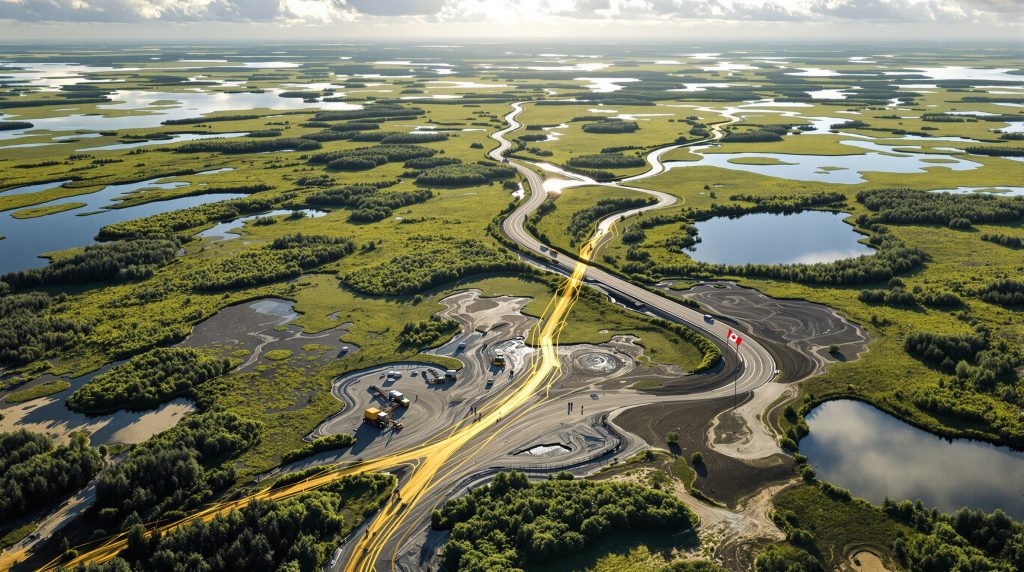Northern Road Link Project: Crucial Infrastructure for Ring of Fire Development
The Northern Road Link represents a crucial transportation corridor for Ontario's mineral-rich Ring of Fire region. This all-season road would connect the proposed Marten Falls Community Access Road with the Webequie Supply Road, creating vital infrastructure in northern Ontario's James Bay Lowlands. Canadian Chrome Company's recent agreement marks a significant step toward addressing one of the region's most persistent challenges: lack of transportation infrastructure.
The project's importance extends beyond mining industry evolution operations, as it would provide essential connectivity for remote First Nations communities while facilitating resource development. After more than a decade of delays due to various challenges, this latest agreement signals renewed momentum for this strategically important infrastructure initiative.
Key Infrastructure Components of the Northern Road Link
The Northern Road Link project encompasses several critical infrastructure elements designed to serve both industry and community needs:
- 330-kilometer transportation corridor connecting remote communities to provincial infrastructure
- Multi-use design supporting both mining operations and First Nations communities
- All-season access through challenging terrain including peatlands and wetlands
- Strategic connection between Marten Falls Community Access Road and Webequie Supply Road
This comprehensive transportation network would form a crucial link in a larger infrastructure system designed to unlock the economic potential of the Ring of Fire while improving quality of life for local communities.
New Supplementary Agreement Between Canadian Chrome and AtkinsRéalis
Canadian Chrome Company (formerly KWG Resources) has signed a supplementary memorandum of agreement with AtkinsRéalis Canada Inc. (formerly SNC-Lavalin) that grants temporary access rights for essential geotechnical work. This agreement represents a collaborative approach to advancing the Northern Road Link project while respecting mineral exploration insights.
The agreement demonstrates a pragmatic approach to infrastructure development in a region where multiple stakeholders, including First Nations communities, mining companies, and various levels of government must coordinate their efforts. By providing temporary access to its claims, Canadian Chrome is facilitating crucial preliminary work while maintaining its long-term interests in the region.
Terms of the Geotechnical Investigation Agreement
The agreement between Canadian Chrome and AtkinsRéalis includes specific terms designed to balance infrastructure development needs with mining claims framework:
- Temporary access rights to sections of Canadian Chrome's mineral exploration claims
- One-year timeframe for completing necessary studies
- Testing at 13 borehole locations for soil analysis and aggregate studies
- Work period scheduled from mid-September through late November 2025
- Data sharing arrangement providing Canadian Chrome with access to study results
This cooperative arrangement ensures that geotechnical investigations can proceed while providing Canadian Chrome with valuable data that may benefit its own exploration and development planning in the area.
First Nations Communities Central to Northern Road Link Development
The Northern Road Link project is unique in that it's being led by Indigenous communities rather than government agencies or mining companies. The Marten Falls and Webequie First Nations are spearheading the environmental assessment process, demonstrating a community-led approach to infrastructure development.
This Indigenous leadership model represents a significant evolution in how major infrastructure projects in northern Ontario are conceptualized and implemented. Rather than being passive participants in development decisions affecting their traditional territories, First Nations communities are taking an active role in shaping infrastructure that will impact their lands and people for generations.
First Nations Leadership in the Project
The First Nations leadership approach incorporates several key elements:
- Environmental assessment proponents are Marten Falls and Webequie First Nations
- Community-centered planning prioritizing local needs alongside development
- Collaborative approach with contractors like AtkinsRéalis working on behalf of First Nations
- Balancing economic opportunities with environmental and cultural considerations
- Self-determination in infrastructure planning affecting traditional territories
This approach ensures that community priorities and traditional knowledge are integrated into project planning from the earliest stages, potentially leading to more sustainable and equitable infrastructure development.
Geotechnical Challenges in the James Bay Lowlands
The James Bay Lowlands present significant engineering and environmental challenges for road construction. The geotechnical investigation will provide critical data about soil conditions, permafrost, and potential aggregate sources in this ecologically sensitive region.
Building infrastructure in this remote northern landscape requires specialized engineering approaches that account for the unique characteristics of muskeg, peatlands, and seasonal freeze-thaw cycles. The current geotechnical work is essential for understanding these conditions and developing appropriate construction methods.
Technical Considerations for Northern Road Construction
Road construction in the James Bay Lowlands must address numerous technical challenges:
- Peatland stability assessment for building on soft, water-saturated ground
- Permafrost considerations in areas with seasonally frozen ground
- Water management strategies for numerous river and stream crossings
- Aggregate source identification for construction materials
- Environmental impact minimization in sensitive wetland ecosystems
These technical considerations will influence road design, construction methods, and long-term maintenance approaches for the Northern Road Link project.
Northern Road Link's Role in Ontario's Critical Minerals Strategy
Ontario's Ring of Fire has been described as one of Canada's most significant undeveloped mining districts, containing deposits of chromite, nickel, copper, and other critical minerals strategy essential for clean energy technologies. The provincial government under Premier Doug Ford has prioritized unlocking this potential through infrastructure investment.
The Northern Road Link forms a cornerstone of Ontario's broader strategy to position itself as a key supplier of critical minerals essential for clean energy technologies and advanced manufacturing. By developing transportation infrastructure, the province aims to overcome one of the primary barriers to mineral development in this remote region.
Strategic Importance to Ontario's Mining Sector
The Northern Road Link holds significant strategic value for Ontario's mining industry:
- Access to chromite deposits including Canadian Chrome's Black Horse discovery
- Critical minerals development supporting clean energy transition technologies
- Billions in infrastructure investment pledged by Ontario government
- Economic diversification for northern Ontario communities
- Supply chain security for minerals essential to manufacturing and technology sectors
As global demand for critical minerals continues to grow, particularly those needed for electric vehicles and renewable energy technologies, developing the Ring of Fire could position Ontario as a significant supplier in North American and global markets.
Decade-Long Delays in Ring of Fire Development
Despite its mineral wealth, Ontario's Ring of Fire has faced numerous obstacles that have delayed development for more than ten years. Understanding these challenges provides context for why the current progress on the Northern Road Link is significant.
The prolonged timeline for development highlights the complex interplay of economic, environmental, social, and political factors that influence major resource projects in Canada. While the current agreement represents progress, it comes after many years of stalled development and shifting approaches.
Historical Challenges to Development
Several key factors have contributed to delays in Ring of Fire development:
- Permitting complexities involving multiple levels of government
- Infrastructure cost barriers for remote region development
- Indigenous consultation requirements and addressing community concerns
- Environmental sensitivities in the James Bay Lowlands ecosystem
- Market fluctuations affecting investment decisions for mining companies
These historical challenges help explain why the Ring of Fire, despite its significant mineral potential, has yet to see full-scale development more than a decade after initial discoveries.
Benefits for Canadian Chrome from the Northern Road Link
While the agreement primarily facilitates work being done on behalf of the First Nations, Canadian Chrome stands to gain valuable insights and potential future benefits from the project's advancement.
The company's strategic positioning in the Ring of Fire region, including its Black Horse chromite discovery, means that transportation infrastructure development directly enhances the value and development potential of its mineral assets. Understanding mining permitting basics is crucial for companies like Canadian Chrome as they navigate the development process.
Strategic Advantages for Canadian Chrome
Canadian Chrome can leverage several advantages from the Northern Road Link development:
- Access to geotechnical data shared by AtkinsRéalis from field studies
- Enhanced exploration planning informed by road development progress
- Potential utility corridor development alongside the transportation route
- Increased value of mineral claims with improved access infrastructure
- Advancement of the company's Black Horse chromite project in the Ring of Fire
By facilitating geotechnical work now, Canadian Chrome positions itself to benefit from infrastructure development that could significantly reduce the capital requirements for its own projects in the future.
Environmental Considerations in the Assessment Process
The environmental assessment process for the Northern Road Link must navigate complex ecological considerations in the James Bay Lowlands, which contain significant wetlands and peatlands that serve important environmental functions.
The James Bay Lowlands represent one of the world's largest intact wetland ecosystems and play a crucial role in carbon sequestration and water filtration. Any infrastructure development must carefully balance economic benefits with environmental protection.
Environmental Assessment Focus Areas
The environmental assessment for the Northern Road Link addresses several critical areas:
- Wetland and peatland protection strategies for sensitive ecosystems
- Wildlife habitat preservation for species in the region
- Water quality maintenance across numerous watersheds
- Carbon storage implications of development in peatland areas
- Climate change resilience considerations for infrastructure design
These environmental considerations will shape the final route selection, construction methods, and operational parameters for the Northern Road Link project.
Timeline for Northern Road Link Development
While the current agreement represents progress, the Northern Road Link faces a complex development timeline with multiple phases of assessment, approval, and construction.
Major infrastructure projects in remote northern regions typically require extended timelines due to seasonal construction windows, complex approval processes, and the need for careful environmental and community engagement. The current geotechnical work represents just one early phase of a multi-year development process.
Project Development Phases and Timelines
The Northern Road Link development will proceed through several distinct phases:
- Current geotechnical work: Mid-September through late November 2025
- Environmental assessment completion: Ongoing process with no fixed end date
- Regulatory approvals: Dependent on assessment outcomes
- Construction planning and preparation: Following approvals
- Actual road construction: Multiple years once approvals are secured
This extended timeline reflects the complexity of major infrastructure development in northern Ontario and the need for thorough assessment and community engagement throughout the process.
Community Benefits from the Northern Road Link
Beyond mining development, the Northern Road Link promises significant benefits for remote First Nations communities that currently lack year-round road access.
For many northern communities, isolation and limited transportation options contribute to high costs of living, reduced access to services, and limited economic opportunities. All-season road access can transform these conditions and create new possibilities for community development.
Community Benefits of All-Season Road Access
The Northern Road Link could deliver numerous community benefits:
- Reduced transportation costs for food, fuel, and essential supplies
- Improved access to healthcare and emergency services
- Enhanced educational opportunities through better connectivity
- Employment opportunities during construction and operation
- Economic development potential beyond the mining sector
These potential benefits explain why First Nations communities are taking a leadership role in advancing the project, seeking to balance economic development with environmental protection and cultural considerations.
FAQ: Northern Road Link Project
What is the Northern Road Link?
The Northern Road Link is a proposed all-season road that would connect the Marten Falls Community Access Road with the Webequie Supply Road, creating a transportation corridor into Ontario's Ring of Fire mining district and connecting remote First Nations communities.
Who is leading the environmental assessment for the Northern Road Link?
The Marten Falls and Webequie First Nations are leading the environmental assessment process as the project proponents, demonstrating Indigenous leadership in infrastructure development affecting their traditional territories.
What is Canadian Chrome's role in the Northern Road Link project?
Canadian Chrome (formerly KWG Resources) holds mineral claims along the proposed route and has granted temporary access for geotechnical investigations while maintaining its vision for a 330-km utility corridor linking the Ring of Fire to Nakina and regional First Nations communities.
What types of minerals are found in Ontario's Ring of Fire?
The Ring of Fire contains significant deposits of chromite, nickel, copper, and other critical minerals essential for clean energy technologies and manufacturing.
What challenges have delayed Ring of Fire development?
Development has been delayed by permitting complexities, infrastructure costs, Indigenous consultation requirements, environmental concerns, and market fluctuations affecting investment decisions.
Disclaimer: This article contains information about potential infrastructure and mining developments. The timeline and eventual completion of these projects depend on numerous factors including regulatory approvals, environmental assessments, community consultations, and market conditions. Readers should not make investment decisions based solely on this information.
Ready to Track the Next Major Mineral Discovery in Australia?
Discover significant ASX mineral discoveries the moment they happen with Discovery Alert's proprietary Discovery IQ model, turning complex exploration data into actionable investment insights. Explore why major mineral discoveries can lead to substantial returns by visiting Discovery Alert's dedicated discoveries page and begin your 30-day free trial today.




